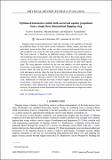Optimized kinematics enable both aerial and aquatic propulsion from a single three-dimensional flapping wing
Author(s)
Izraelevitz, Jacob Samuel; Kotidis, Miranda P.; Triantafyllou, Michael S
DownloadPhysRevFluids.3.073102.pdf (5.851Mb)
PUBLISHER_POLICY
Publisher Policy
Article is made available in accordance with the publisher's policy and may be subject to US copyright law. Please refer to the publisher's site for terms of use.
Terms of use
Metadata
Show full item recordAbstract
Flapping wings in nature demonstrate a large force envelope, with capabilities far beyond the traditional limits of static airfoil section coefficients. Puffins, murres, and other auks particularly showcase this effect, as they are able to generate both enough thrust to swim and enough lift to fly, using the same wing, purely by changing the wing motion trajectory. The wing trajectory is therefore an additional design criterion to be optimized along with traditional aircraft parameters and could open the door to dual aerial-aquatic robotic vehicles. In this paper we showcase one realization of a three-dimensional flapping-wing actuation system that reproduces the force coefficients necessary for dual aerial-aquatic flight. The wing apparatus oscillates by the root and employs an active upstream and downstream sweep degree of freedom. We analyze two types of motions in detail: aerial motions where the wing tip moves upstream during the power stroke of each flapping cycle and aquatic motions where the wing tip moves downstream during the power stroke. We design these aerial and aquatic flapping-wing trajectories using an experiment-coupled optimization routine, allowing control of the unsteady forces throughout each flapping cycle. Additionally, we elucidate the wakes of these complex wing trajectories using dye visualization, correlating the wake vortex structures with simultaneous experiment force measurements. After optimization, the wing trajectories generate the large force envelope necessary for propulsion in both fluid media and furthermore demonstrate improved control over the unsteady wake.
Date issued
2018-07Department
Massachusetts Institute of Technology. Department of Mechanical EngineeringJournal
Physical Review Fluids
Publisher
American Physical Society
Citation
Izraelevitz, Jacob S. et al. "Optimized kinematics enable both aerial and aquatic propulsion from a single three-dimensional flapping wing." Physical Review Fluids 3, 7 (July 2018): 073102 © 2018 American Physical Society
Version: Final published version
ISSN
2469-990X
2469-9918